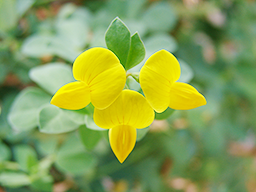About Lotus japonicus
 Lotus japonicus is a perennial legume naturally growing in East and Central Asia, including Japan, Korea, and China. It has been used as a model legume since 1992 because of its short generation time, abundant flowers, small diploid genome, amenability to tissue culture and Agrobacterium transformation, self-compatibility, and inter- and intra-specific fertility enabling genetic mapping. It has been widely used in a wide range of research fields, including plant-microbe interactions, and a large number of mutant lines displaying phenotypic aberrations were identified. Two experimental accessions B-129 and MG-20 were collected from Gifu and Miyakojima in Japan, respectively, and more than 200 additional accessions have been collected from their natural habitats in Japan.
Lotus japonicus is a perennial legume naturally growing in East and Central Asia, including Japan, Korea, and China. It has been used as a model legume since 1992 because of its short generation time, abundant flowers, small diploid genome, amenability to tissue culture and Agrobacterium transformation, self-compatibility, and inter- and intra-specific fertility enabling genetic mapping. It has been widely used in a wide range of research fields, including plant-microbe interactions, and a large number of mutant lines displaying phenotypic aberrations were identified. Two experimental accessions B-129 and MG-20 were collected from Gifu and Miyakojima in Japan, respectively, and more than 200 additional accessions have been collected from their natural habitats in Japan.
Large scale genome sequencing of MG-20 was launched in 2001 at the Kazusa DNA Research Institute, and the first version of a Sanger-based genome assembly (v. 1.0) was released in 2008. In 2010, an updated genome sequence, v. 2.5, was constructed by adding genome sequence information from 460 TAC/BAC clones. The latest version of reference genome sequence, v3.0, is based on a hybrid assembly of Sanger TAC/BAC, Sanger shotgun and Illumina shotgun sequencing data generated from the Miyakojima-MG-20 accession.
In this database, we present a high-quality L. japonicus Gifu (accession B-129) reference assembly constructed by utilizing 100x PacBio read coverage combined with Hi-C data and new high-density genetic maps. The assembly comprises 554 megabases of which 549 were assigned to six pseudomolecules that appear complete with telomeric repeats at their extremes and large centromeric regions with low gene density. The new L. japonicus Gifu reference genome represents valuable resources for legume functional and comparative genomics.